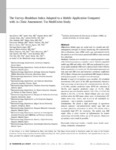Mostrar o rexistro simple do ítem
The Harvey–Bradshaw Index adapted to a mobile application compared with In-clinic assessment: the MediCrohn Study
| dc.contributor.author | Echarri, Ana | |
| dc.contributor.author | Vera, Isabel | |
| dc.contributor.author | Arajol, Claudia | |
| dc.contributor.author | Riestra, Sabino | |
| dc.contributor.author | Robledo, Pilar | |
| dc.contributor.author | Calvo, Marta | |
| dc.contributor.author | Gallego, Francisco | |
| dc.contributor.author | Ceballos, Daniel | |
| dc.contributor.author | Castro, Beatriz | |
| dc.contributor.author | Aguas, Miriam | |
| dc.contributor.author | García-López, Santiago | |
| dc.contributor.author | Marín-Jiménez, Ignacio | |
| dc.contributor.author | Chaparro, María | |
| dc.contributor.author | Mesonero, Paco | |
| dc.contributor.author | Guerra, Iván | |
| dc.contributor.author | Guardiola, Jordi | |
| dc.contributor.author | Nos, Pilar | |
| dc.contributor.author | Muñiz, Javier | |
| dc.date.accessioned | 2020-01-30T13:18:33Z | |
| dc.date.available | 2020-01-30T13:18:33Z | |
| dc.date.issued | 2020-01-07 | |
| dc.identifier.citation | Echarri A, Vera I, Ollero V, et al. The Harvey–Bradshaw Index adapted to a mobile application compared with In-clinic assessment: the MediCrohn Study. Telemed J E Health. 2020; 26(1):78-86 | es_ES |
| dc.identifier.issn | 1530-5627 | |
| dc.identifier.uri | http://hdl.handle.net/2183/24797 | |
| dc.description.abstract | [Abstract] Objectives: Mobile apps are useful tools in e-health and self-management strategies in disease monitoring. We evaluated the Harvey–Bradshaw index (HBI) mobile app self-administered by the patient to see if its results agreed with HBI in-clinic assessed by a physician. Methods: Patients were enrolled in a 4-month prospective study with clinical assessments at months 1 and 4. Patients completed mobile app HBI and within 48 h, HBI was performed by a physician (gold standard). HBI scores characterized Crohn's disease (CD) as remission <5 or active ≥5. We determined agreement per item and total HBI score and intraclass correlation coefficients (ICCs). Bland–Altman plot was performed. HBI changes in disease activity from month 1 to month 4 were determined. Results: A total of 219 patients were enrolled. All scheduled assessments (385 pairs of the HBI questionnaire) showed a high percentage of agreement for remission/activity (92.4%, κ = 0.796), positive predictive value (PPV) for remission of 98.2%, and negative predictive value of 76.7%. High agreement was also found at month 1 (93.15%, κ = 0.82) and month 4 (91.5%, κ = 0.75). Bland–Altman plot was more uniform when the HBI mean values were <5 (remission). ICC values were 0.82, 0.897, and 0.879 in all scheduled assessments, 1 and 4 months, respectively. Conclusions: We found a high percentage of agreement between patients' self-administered mobile app HBI and in-clinic physician assessment to detect CD activity with a remarkably high PPV for remission. The mobile app HBI might allow a strict control of inflammation by remote monitoring and flexible follow-up of CD patients. Reduction of sanitary costs could be possible. | es_ES |
| dc.language.iso | eng | es_ES |
| dc.publisher | Mary Ann Liebert, Inc. | es_ES |
| dc.relation.uri | http://doi.org/10.1089/tmj.2018.0264 | es_ES |
| dc.rights | Creative Commons Attribution 4.0 International License (CC-BY 4.0) | es_ES |
| dc.rights.uri | http://creativecommons.org/licenses/by/4.0/ | * |
| dc.subject | Behavioral health | es_ES |
| dc.subject | e-health | es_ES |
| dc.subject | Home health monitoring | es_ES |
| dc.subject | Telehealth | es_ES |
| dc.subject | Telemedicine | es_ES |
| dc.title | The Harvey–Bradshaw Index adapted to a mobile application compared with In-clinic assessment: the MediCrohn Study | es_ES |
| dc.type | info:eu-repo/semantics/article | es_ES |
| dc.rights.access | info:eu-repo/semantics/openAccess | es_ES |
| UDC.journalTitle | Telemedicine and e-Health | es_ES |
| UDC.volume | 26 | es_ES |
| UDC.issue | 1 | es_ES |
| UDC.startPage | 78 | es_ES |
| UDC.endPage | 86 | es_ES |
Ficheiros no ítem
Este ítem aparece na(s) seguinte(s) colección(s)
-
GI- GRINCAR - Artigos [226]






